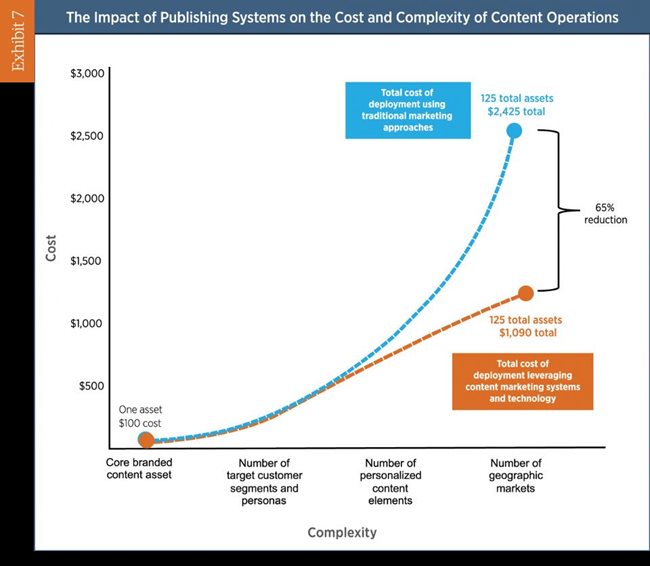What Has Taken Personalization So Long to Become Mainstream?
It is no secret that personalization provides lucrative results. In fact, according to Forbes’ study entitled “Publish or Perish analysis of 380 CMOs”, marketers that deliver personalized web experiences are getting double digit returns in marketing performance and response. Besides this research, there is a tremendous amount of statistics out there on how personalized content has an impact on purchasing decisions and how companies make delivering personalization their top priority. Unfortunately, personalization technology has generated more discussion than results so far, so in this article, we will discuss the impediments and what has taken personalization technology so long to truly become mainstream.
 When a person asks you why it’s taken so much time for personalization technology to deliver on its promises, there is a good chance you would think the primary reasons are technical. Well, you would be totally right, if it was asked a couple of years ago. Technology has been maturing and improving, as our news contributor and Marketing Technology Analyst Barb Mosher Zinck stated in her latest post, “the demand for personalized experiences is driving WCM vendors to adopt stronger, more tightly integrated personalization capabilities.” As a result, many vendors today, provide very viable personalization solutions either through acquisitions and strong partnership or from building the capabilities in-house but still it is fair to say that dynamic content such as dynamic product pages or “predictive” ads are not at their best but, we keep seeing very popular sites like Facebook making predictive assumptions based on a one-off shopping experiences.
When a person asks you why it’s taken so much time for personalization technology to deliver on its promises, there is a good chance you would think the primary reasons are technical. Well, you would be totally right, if it was asked a couple of years ago. Technology has been maturing and improving, as our news contributor and Marketing Technology Analyst Barb Mosher Zinck stated in her latest post, “the demand for personalized experiences is driving WCM vendors to adopt stronger, more tightly integrated personalization capabilities.” As a result, many vendors today, provide very viable personalization solutions either through acquisitions and strong partnership or from building the capabilities in-house but still it is fair to say that dynamic content such as dynamic product pages or “predictive” ads are not at their best but, we keep seeing very popular sites like Facebook making predictive assumptions based on a one-off shopping experiences.
If the reason is not entirely about a lack of relevant technology, then what are the roadblocks? Glad you asked! Although I will get back to the recent personalization technology improvements in the content management industry, it’s important to discuss the non-technical hold-ups.
Misperception on the Cost of Personalization Technology
I’m not saying that implementing personalization technology is an easy and cheap task but the opportunity cost can easily add up to be more than your total cost of having the right technology in place. Let me explain this through a chart by Forbes below, that demonstrates the impact of the publishing system on the cost and complexity of content operations:

After all, one of the biggest challenges that marketing teams are facing is the pressure created by the exploding demand for well organized, high quality, and personalized content. To address the growing need for personalized content, organizations need to have the web content management solutions that provide intelligent content frameworks, as well as scales the volume, cost, and complexity of content personalization in place. Moreover, according to Alison Lewis, the CMO of Johnson & Johnson: “Getting the right message to the right person at the right time has never been easier, driven by digital and data. Content needs are exploding as we move to a world of precision marketing and 24/7 engagement.”
Under-resourced Departments and Disconnection
Since many marketing departments are under-resourced, they tend to pay closer attention to quick wins and mid-term projects. Personalization is neither a short/mid-term project nor a task that only concerns a single department. It takes real teamwork to set up, implement, and optimize a strategy. Generally speaking, long-term projects like personalization technology implementation take a back seat not only because of the lack of staff, but also because of the lack of alignment with other internal departments. Without a clear alignment on the goals, execution, deployment, and strategy, it is impossible to deliver a personalized user experience across all touchpoints.
Yes, there is an exchange of profitable benefit to the organizations for a little bit of time and effort being given away to each department of the organizations.
Confusion over What Personalization Really Means
The term personalization has been discussed in broad terms without a lot of solidity behind it. Therefore, so many organizations have made personalization projects a top priority just because it’s in vogue, and as a result, those projects have gone nowhere as they actually couldn’t assess what they want to accomplish with the projects, and what the technical requirements and roadblocks were without knowing what it really means.
With many thought leaders in the space, we, CMS-Connected, as the content management industry’s headline news, articles & commentary source, are also responsible for being more educational when we discuss buzzwords rippling through the industry. Therefore, I did research to find out where the confusion begins so we could solve the problem at its source. Believe or not, there is an expansive lack of understanding of the difference between these terms: Personalization, Customization, and Relevance.
According to the Nielson Norman Group, personalization is done by the system being used while customization is done by the user. To put this in context, with personalization, you can provide the customers a better experience out of the box, by interpreting their preferences without any additional effort on their part but with customization, you enable your customers to make changes to their experience, depending on their specific needs and priorities.
On the other hand, relevancy is not a synonym for personalization either as the relevance experience concerns more about driving business value by improving content relevance. To do so, there are so many tools that can assist, and personalization is one of them. In other words, delivering “relevant experiences” is the overarching strategy whereas “personalization” is one tactic of execution. I mean at the end of the day, there are times that you can have a relevant experience by only customizing without any personalization capabilities in place. But the high demand for personalization arises from the consumers’ expectation from, say, retailers to know more about them than they actually do.
The Impact on the Future of the WCM Market
After briefly covering the non-tech factors that have a negative impact on the wide adoption of personalization technology, let’s shed light on where the WCM industry goes with personalization by assessing the most recent technology improvements in the space.
We have recently covered a sheer volume of news about vendors acquiring some platforms, teaming up with other vendors, or simply adding new enhancements to their suites in an effort of beefing up their platforms with stronger, more tightly integrated personalization capabilities.
Amsterdam-based Web CMS/digital experience platform Hippo, for instance, was acquired by BloomReach , a California-based e-commerce personalization startup. As soon as the news broke, CMS-Connected reached to CEO Raj De Datta to talk about the biggest motivation behind the deal. According to him, it all started when they saw a need for disruption in the web content management space which developed into a mission to extend personalization and relevant contextual experience to all digital business. To put it simply, they feel a lot of content management systems haven’t had enough intelligence built into them. He also pointed out that intelligence seems like a new conversation in the WCM space but Bloomreach has been applying this artificial intelligence and machine learning technology to its commerce platform for seven years. So the company believes that this acquisition will allow them to apply this expertise to the web content management space to truly begin to make a difference. To achieve this mission, BloomReach chose Hippo as De Datta believes Hippo is a visionary in the space, similar to how Gartner positioned them in its Magic Quadrant report. When we asked the reason, he spoke highly about Hippo’s architecture, its on-demand approach, and its current analytics capabilities. We also had a chance to discuss the acquisition with Jeroen Verberg, CEO and Co-founder of Hippo, and it was easy to see that both leaders were sharing the same mindset and were equally excited about the acquisition. Jeroen Verberg also talked about the WCM industry being in need of deeper innovation and radical changes. Therefore, he mentioned about the current plans to expand their engineering teams at three very different locations around the world. Here's what he had to say:
, a California-based e-commerce personalization startup. As soon as the news broke, CMS-Connected reached to CEO Raj De Datta to talk about the biggest motivation behind the deal. According to him, it all started when they saw a need for disruption in the web content management space which developed into a mission to extend personalization and relevant contextual experience to all digital business. To put it simply, they feel a lot of content management systems haven’t had enough intelligence built into them. He also pointed out that intelligence seems like a new conversation in the WCM space but Bloomreach has been applying this artificial intelligence and machine learning technology to its commerce platform for seven years. So the company believes that this acquisition will allow them to apply this expertise to the web content management space to truly begin to make a difference. To achieve this mission, BloomReach chose Hippo as De Datta believes Hippo is a visionary in the space, similar to how Gartner positioned them in its Magic Quadrant report. When we asked the reason, he spoke highly about Hippo’s architecture, its on-demand approach, and its current analytics capabilities. We also had a chance to discuss the acquisition with Jeroen Verberg, CEO and Co-founder of Hippo, and it was easy to see that both leaders were sharing the same mindset and were equally excited about the acquisition. Jeroen Verberg also talked about the WCM industry being in need of deeper innovation and radical changes. Therefore, he mentioned about the current plans to expand their engineering teams at three very different locations around the world. Here's what he had to say:
Hippo is not the first and certainly won’t be the last to partake in this type of acquistion. Episerver’s recent acquisition of Peerius, another personalization platform, the partnership between Acquia, a Drupal-based open source content management system provider, and Magento Commerce, the open source e-commerce platform provider, or e-Spirit’s newly launched Content-as-a-Service Solution, FirstSpirit CaaS, are only a few of the latest efforts by vendors in order to deliver highly personalized, content-rich experiences across every touchpoint.
Last but certainly not least, personalization is a sophisticated and complex area so make sure you have a solid grasp on what your goals are and what to expect. Don’t forget that it is a team effort so see if you have a strong UX expert and Information Architect on your team who will lead the project to integrate personalization into the core of your content management platform. Instead of attempting a “Big Bang”, start small by applying it to where it makes the most sense, then assess and experiment what worked and what didn’t to finally, expand to other areas of your site.

Venus Tamturk
Venus is the Media Reporter for CMS-Connected, with one of her tasks to write thorough articles by creating the most up-to-date and engaging content using B2B digital marketing. She enjoys increasing brand equity and conversion through the strategic use of social media channels and integrated media marketing plans.